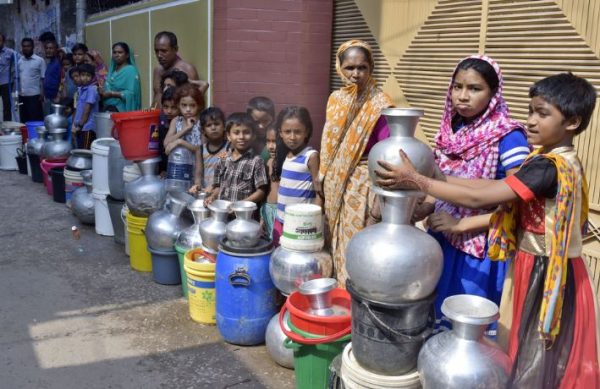

A Sight Too Common
June 2019 ended with the monsoon deficient by 33%. Today, on July 3, with pictures of Mumbai reeling from its annual monsoon inundation, might already seem irrelevant to some people, but believe us, its isn’t. Keep in mind that the Mumbai ‘floods’ are an annual feature, and reflective more of the state of preparedness of the city than the monsoons. Though with the sheer volume of rains it has regularly started receiving in very short spells of 2-3 days, the city needs some slack too, if it struggles.
Having said that, Maharashtra remains among the worst affected states from deficient rainfall, with regions like Marathwada, and Vidarbha almost becoming a byword for droughts and farmer suicides. As always, there will be arguments against this view too, but there should be do denying that like most of India, Maharashtra too has little to show for its drought mitigation efforts. The Chief Ministers Jalyukt Shivir Abhiyan, (loosely translated as the water adequacy and conservation movement) was launched in January 2016, with the aim of making the state drought proof by 2019.
Even its biggest fans will admit that the state is nowhere close to that target. The signs are ominous. Public participation, which was to be the cornerstone of the scheme, has dropped continuously after a roaring start in 2016. The statistics show the number of public-driven projects under the scheme moved from 6,374 in 2015-16 to 3,214 in 2016-17 and finally just 1,104 (2017-18). As of now, the scheme has almost been abandoned, with the number down to 30 in 2018-19.
Many reasons have been cited for its struggles, from a shift to individual projects from public projects by villagers, to ‘contractor capture’, to failure to engage the people, and more. But the bottom line is that barely 128 our of 6027 villages that were targeted to become water neutral, have actually been declared so.
It’s the same story with the laws governing water harvesting, where we have given ourselves some of the world’s best laws with no way to track and monitor implementation. Or penalise wilful indifference.
A classic example of how government intent versus ability plays out is visible today. The Delhi government, managing one of the most thirsty cities with the highest external dependence for water has just announced a plan for digging small ponds along a 20 kilometre stretch of the Yamuna river, to help capture flood runoff and benefit the groundwater along the river. With a big caveat. All this, subject to the approval of the central government and relevant authorities.
This multiplicity of authorities is not just a Delhi problem. It’s a problem in virtually every state and municipality, serving as a convenient way to shift blame and accountability, even as more and more ‘water mafias’ gain mainstream acceptance and groundwater depletion continues at its merry pace.
Dark is the reality in cities like Chennai and Bengaluru where builders have merrily usurped wetlands and lakes to build apartments and offices. Such is the scarcity of water now that many corporates have instructed their employees to work from home as buying water was adding to their overhead costs. Spare a thought for the employee who was stealing a shower at work for there was no water at home. And imagine the conundrum: probably there would have been water only if the lake or that wetland had been spared.
The central government has acknowledged the crisis, albeit a tad late, led by Prime Minister Narendra Modi’s appeal to conserve water in his first “Mann Ki Baat” of his second term. “When people will join hands, water will be conserved” PM Modi said while asking for a joint effort from people to save water.
“We together should all resolve to save every drop of water and I believe that water is God’s prasad to us, water is like philosopher’s stone!”, PM Modi said. This message and the creation of the separate Jal Shakti ministry will no doubt provide the much needed impetus to do whatever it takes to save water but then, one fears that this may have come a bit late.
The import of PM’s message was lost on India’s lawmakers though when a near-empty Rajya Sabha was left to debate on India’s water crisis.
Since Indians are ‘resilient by force, not by choice’, it is we the people who now have to come together to save water and stave off the crisis.
And the good news is that we are finally at crisis time. Cape Town’s day zero seems like a welcome relief to large sections of the population in mega cities like Chennai, besides many smaller cities across the country’s North and Western regions.
All the announcements or declaration of intent are done and over with. After all, piped drinking water for every household is no mean target, with less that 20% households covered right now. The Jal Shakti Ministry has been duly constituted, with multiple water related ministries merged under its umbrella. The monsoon is finally here.
The curtain raiser for the 2nd edition of the India Bioenergy & Tech Expo (IBETE…
In light of the ongoing debate on whether flue gas desulphurisation (FGD) systems in coal-fired…
In a key step toward advancing clean energy adoption, Ahmedabad headquartered IRM Energy Ltd has…
Biofuels conglomerate Aemetis has announced that its subsidiary in India – Universal Biofuels – has…
The Greater Noida Industrial Development Authority (GNIDA) has commenced construction of a 300-tonne-per-day (TPD) bio-CNG…
The World Earth Day – with this year’s theme on ‘Our Power, Our Planet’ –…